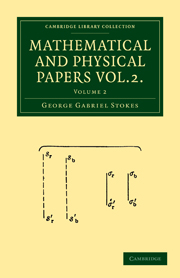Book contents
- Frontmatter
- Contents
- Notes on Hydrodynamics. III. On the Dynamical Equations
- On the constitution of the Luminiferous Ether
- On the Theory of certain Bands seen in the Spectrum
- Notes on Hydrodynamics. IV. Demonstration of a Fundamental Theorem
- On a difficulty in the Theory of Sound
- On the Formation of the Central Spot of Newton's Rings beyond the Critical Angle
- On some points in the Received Theory of Sound
- On the perfect Blackness of the Central Spot in Newton's Rings, and on the Verification of Fresnel's Formula for the intensities of Reflected and Reflacted Rays
- On Attractions, and on Clairaut's Theorem
- On the Variation of Gravity at the Surface of the Earth
- On a Mode of Measuring the Astigmatism of a Defective Eye
- On the Determination of the Wave Length corresponding with any Point of the Spectrum
- Discussion of a Differential Equation relating to the Breaking of Railway Bridges
- Notes on Hydrodynamics, VI. On Waves
- On the Dynamical Theory of Diffraction
- On the Numerical Calculation of a class of Definite Integrals and Infinite Series
- On the Mode of Disappearance of Newton's Rings in passing the Angle of Total Internal Reflection
- On Metallic Reflection
- On a Fictitious Displacement of Fringes of Interference
- On Haidinger's Brushes
- Index
On the Theory of certain Bands seen in the Spectrum
Published online by Cambridge University Press: 07 September 2010
- Frontmatter
- Contents
- Notes on Hydrodynamics. III. On the Dynamical Equations
- On the constitution of the Luminiferous Ether
- On the Theory of certain Bands seen in the Spectrum
- Notes on Hydrodynamics. IV. Demonstration of a Fundamental Theorem
- On a difficulty in the Theory of Sound
- On the Formation of the Central Spot of Newton's Rings beyond the Critical Angle
- On some points in the Received Theory of Sound
- On the perfect Blackness of the Central Spot in Newton's Rings, and on the Verification of Fresnel's Formula for the intensities of Reflected and Reflacted Rays
- On Attractions, and on Clairaut's Theorem
- On the Variation of Gravity at the Surface of the Earth
- On a Mode of Measuring the Astigmatism of a Defective Eye
- On the Determination of the Wave Length corresponding with any Point of the Spectrum
- Discussion of a Differential Equation relating to the Breaking of Railway Bridges
- Notes on Hydrodynamics, VI. On Waves
- On the Dynamical Theory of Diffraction
- On the Numerical Calculation of a class of Definite Integrals and Infinite Series
- On the Mode of Disappearance of Newton's Rings in passing the Angle of Total Internal Reflection
- On Metallic Reflection
- On a Fictitious Displacement of Fringes of Interference
- On Haidinger's Brushes
- Index
Summary
Some months ago Professor Powell communicated to me an account of a new case of interference which he had discovered in the course of some experiments on a fluid prism, requesting at the same time my consideration of the theory. As the phenomenon is fully described in Professor Powell's memoir, and is briefly noticed in Art. 1 of this paper, it is unnecessary here to allude to it. It struck me that the theory of the phenomenon was almost identical with that of the bands seen when a spectrum is viewed by an eye, half the pupil of which is covered by a plate of glass or mica. The latter phenomenon has formed the subject of numerous experiments by Sir David Brewster, who has discovered a very remarkable polarity, or apparent polarity, in the bands. The theory of these bands has been considered by the Astronomer Royal in two memoirs “On the Theoretical Explanation of an apparent new Polarity of Light,” printed in the Philosophical Transactions for 1840 (Part II.) and 1841 (Part I.). In the latter of these Mr Airy has considered the case in which the spectrum is viewed in focus, which is the most interesting case, as being that in which the bands are best seen, and which is likewise far simpler than the case in which the spectrum is viewed out of focus.
- Type
- Chapter
- Information
- Mathematical and Physical Papers , pp. 14 - 35Publisher: Cambridge University PressPrint publication year: 2009First published in: 1883



